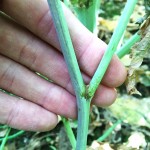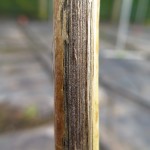Population and pathogenicity dynamics of the Brassica pathogen Verticillium longisporum
Researcher / PhD Candidate : Jasper Depotter

Jasper is investigating the impact of British Verticillium isolates on oilseed rape. Recently, this pathogen was reported in the UK for the first time on this crop. Jasper will trace the geographical origin of Verticillium and assess the variety within the British population. In addition, the genome of a couple of isolates will be sequenced and subsequently analysed to find intraspecific variation related to the pathogenicity of Verticillium.
Verticillium disease in oilseed rape is caused by V. longisporum. The crop develops unilateral dark stripes on the stem at the end of the growing season. In a further stage, the stem may crack and microsclerotia appear on the stem surface. In contrast to other crops, Verticillium causes no wilting symptoms on oilseed rape, but rather accelerates the senescence of the crop at the end of the growing season.
Jasper started his four year project in September 2014 and will partly spend his time in Wageningen (Netherlands) and Cambridge (UK). He is originally from Belgium and studied for his BSc and MSc in Bioscience Engineering at the University of Ghent. Jasper did his MSc thesis at the phytopathology laboratory of Gent University with prof. dr. ir. M. Höfte as promotor. Here Jasper investigated the interactions between benign and pathogenic Verticillium isolates in tomato. Jasper was appointed the Max-CROP project the same year of his graduation.
Summary of Project Findings
A global V. longisporum collection, comprised of 88 isolates from nine different countries was constructed. A population study revealed that the UK population was genetically more diverse than V. longisporum populations from different countries. Consequently, the recent emergence of Verticillium stem striping disease on oilseed rape in the UK is likely caused by a longer established V. longisporum population in the UK (Depotter et al. 2017a). The virulence of UK V. longisporum isolates was therefore accessed, however UK isolates were as virulent on Brassica host as previously characterized V. longisporum isolates from the A1/D1 lineage (Depotter et al. 2017b). Field assessment of oil seed rape varieties to V. longisporum identified variation in resistance. However, the impact of V. longisporum on yield was inconsistent (Depotter et al. 2018a).
ESR 4 sequenced the genomes of two V. longisporum isolates (Depotter et al. 2017a). It was found that V. longisporum has a mosaic genome structure due to recombination between parental chromosome sets (Depotter et al. 2018b), and that V. longisporum genes have generally a more divergent evolution than genes from non-hybrid Verticillium species. Expression patterns of the two V. longisporum sub-genomes show remarkable similarity, in particular expression levels of genes encoding secreted proteins homogenize upon plant colonization. The parental mitochondrial genomes recombined, resulting a mosaic structure of the V. longisporum mitochondrial genome (Depotter et al. 2018b).
SUPERVISORS:
Wageningen University : Prof. dr. ir. Bart P. H. J. Thomma
NIAB : Dr. Thomas A. Wood

